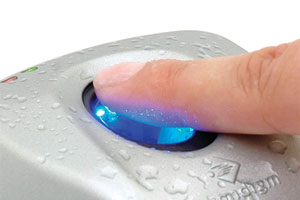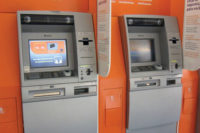
|
|
When it comes to large databases and high throughput, end users and integrators often recommend fingerprint solutions. |
“User friendliness was one of our primary goals and we have that in this biometrics-based system,” says Valerie Dargan, director of the Bergen County
Department of Human Services. The system better identifies homeless individuals and allows access to services provided by the county.
StandAlone Solutions
Many biometrics are available in a standalone configuration. Such devices are not only a biometric, but also a complete door controller for a single door. Users are enrolled at the unit and their biometric template is stored locally for subsequent comparison. The actual comparison is accomplished within the unit and a lock output is energized depending on the outcome.
Smart cards raise the bar even higher, providing additional capabilities and flexibilities. For more on smart cards, go to the Security magazine online archive at www.securitymagazine.com. As costs begin to come down and use is more widespread, biometric devices can leverage their secure data storage. For instance, a single smart card can store both the user’s ID number and biometric template. Because of this, there is no need to distribute templates across a network of readers or require the access control system to manage biometric templates. This means integration to any existing access control application is greatly simplified, eliminating extra network infrastructure costs.
Integration with Access Systems
Biometric manufacturers offer a variety of different methods to integrate biometrics into conventional access control systems. The most common way is “card reader emulation.” This method is effective when integrating into existing card-based systems to bring extra security to the front entrance or server room. The wiring is identical to the card reader’s wiring.
In this mode, the biometric device essentially works with the access control panel in the exact same way that a card reader does. The “card reader output port” of the biometric is connected to the panel’s card reader port. When a person uses the biometric, it outputs the ID number of the individual if, and only if, he or she is verified.
Some biometric readers also have a card reader input capability, the most common being proximity and smart cards, although other technologies are also
In Bergen County’s Housing, Health and Human Services Center, technology from Fulcrum Biometrics’ fingerprint technology identifies, tracks and provides access to authorized persons into various benefits programs. Working with integrator New Jersey Business Systems, the new system provides more accurate identification of homeless individuals who are seeking and receiving services from the county and feed more detailed data to the larger New Jersey state database, a repository of homeless population information that helps to serve the community through food, clothing and housing programs. By providing more accurate identification and eliminating duplicate records, the county will be able to better support funding requests and grant applications, further enhancing services provided to the homeless community.supported. At the biometric unit, the user swipes his or her card, which contains the individual ID number. If verified, that card number is sent up to the panel for a decision.
| Beyond Government Apps: Diverse Commercial Uses |
|
According to the International Biometrics & Identification Association, there are a growing variety of applications beyond government and military uses. As examples: Access Control for Safety, Security Convenience • Safes or Safe Deposit Systems • Logical Access to Network Systems • Log-on Convenience for Enterprise Networks Educational Applications • School Lunch Programs • Parent/Guardian Verification for Child Release • Online Educational Identity Verification Healthcare Applications • Service Provider Security to Protect Patient Privacy • Patient Delivery Verification Protecting Patent and Provider Industrial Applications • Time and Attendance Systems • Industrial PCs |




